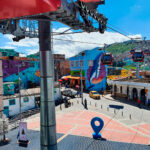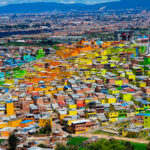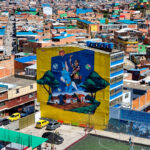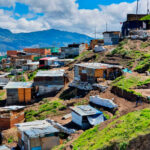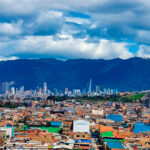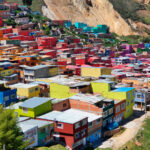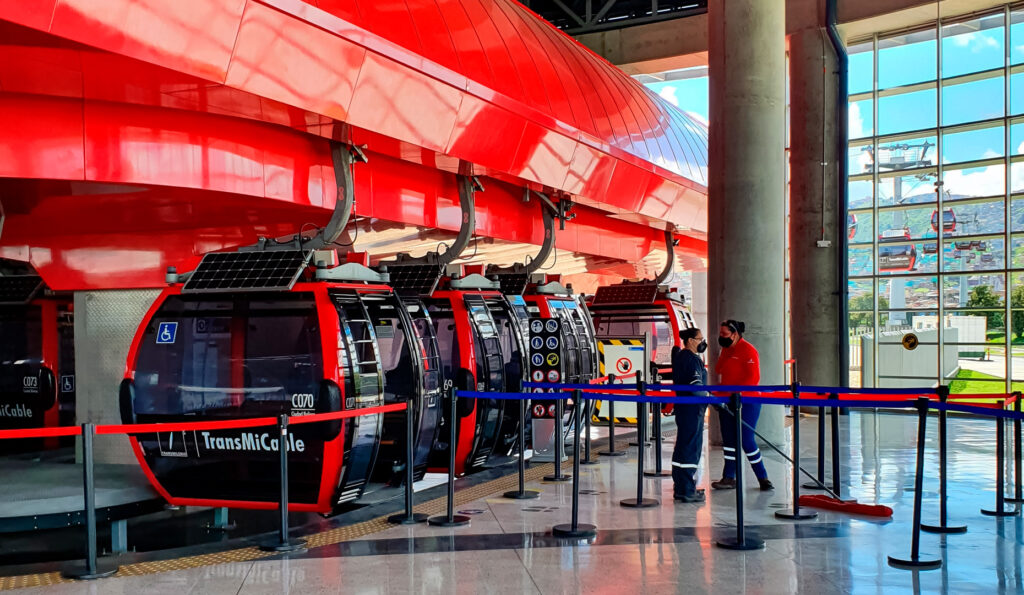
Siempre he mirado de lejos las coloridas casas de las colinas del sur de Bogotá y hoy quiero verlas de cerca. Tomamos un taxi hasta la estación de TransMicable de Ciudad Bolívar. Este gran distrito está situado en el sur de Bogotá. Si se incluyen los distritos vecinos de Soacha y Usme, más de un tercio de los bogotanos viven aquí. A menudo en muy malas condiciones. Ciudad Bolívar es un barrio marcado por la violencia, la delincuencia, la droga y la falta de perspectiva.
Mi acompañante me dice que no vamos a salir del teleférico por razones de seguridad. El teleférico TransMiCable se inauguró en 2018 para ofrecer a los residentes una conexión más rápida con el centro de la ciudad.
El viaje en teleférico es muy impresionante. Son las numerosas casas pintadas de colores, los grafitis y el colorido bullicio de las calles lo que atrae nuestra mirada. La vista panorámica de la metrópolis urbana de Bogotá es fenomenal. Vemos niños jugando, escuelas, campos deportivos y tiendas. Todo parece tan normal y por desgracia no lo es. Muchas personas viven aquí en el umbral de la pobreza, en condiciones extremas.
Al llegar a la estación superior, también tenemos una vista de las barracas de hojalata. Esta vista es muy deprimente y siento un gran respeto por las personas que tienen que vivir aquí.
En el camino de vuelta, una mujer mayor se une a nosotros en la cabina. Miro un rostro marcado por la tristeza y los problemas. Las coloridas casas de este lugar conforman un hermoso paisaje urbano y se supone que expresan la alegría de vivir. Pero en realidad es sólo un engaño. Detrás de los coloridos muros y en las calles hay problemas muy arraigados.
Nuestro estado de ánimo es un poco triste cuando llegamos de nuevo a la estación del valle. Fue una experiencia muy buena para mí y ayuda a entender la vida cotidiana y la gente de Bogotá.
A ride on the TransMiCable cable car over Ciudad Bolívar.
I have always looked at the colorful houses on the hilltops from afar, and today I want to see them up close. We take a cab to the TransMicable station of Ciudad Bolívar. This large district is located in the south of Bogota. If you include the neighboring districts of Soacha and Usme, more than a third of all Bogotans live here. Often in very poor conditions. Ciudad Bolívar is a district characterized by violence, crime, drugs and a lack of perspective.
My companion points out to me that we will not leave the cable car, for safety reasons. The TransMiCable cable car was opened in 2018 to provide a faster connection to the center for residents.
The ride on the cable car is very impressive. It is the many colorfully painted houses, the graffiti and the colorful hustle and bustle on the streets that attract our eyes. The panoramic view of the urban metropolis of Bogota, is phenomenal. We see children playing, schools sports fields and stores. Everything seems so normal and unfortunately it is not. Here, many people live on the lowest poverty line, under extreme conditions.
Arriving at the top station, we also have the view of the tin hut slums. This view is very oppressive and I have great respect for the people who have to live here.
On the way back, an elderly woman joins us in the cabin. I look into a face marked by sadness and problems. The colorful houses here make a beautiful cityscape and are supposed to express joy of life. But actually it is only a deception. Behind the colorful walls and on the streets there are deep problems.
Our mood is a bit sad when we arrive back at the valley station. It was a very good experience for me and it helps to understand the daily life and the people of Bogota.
